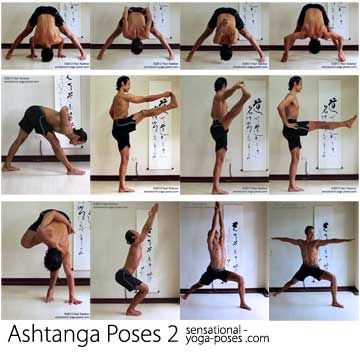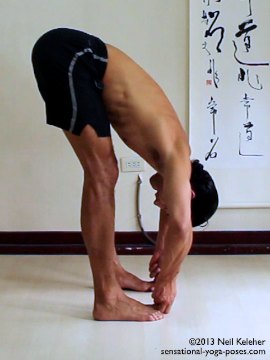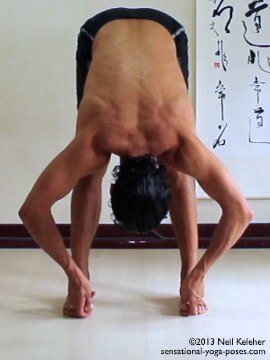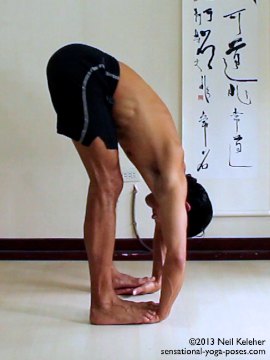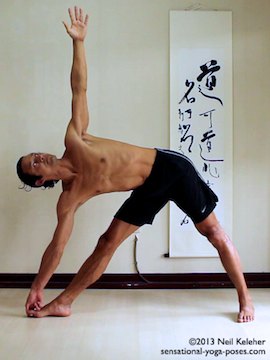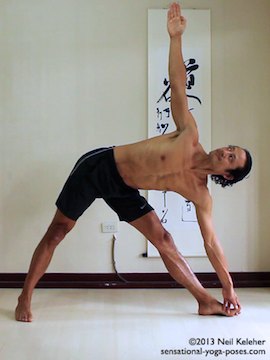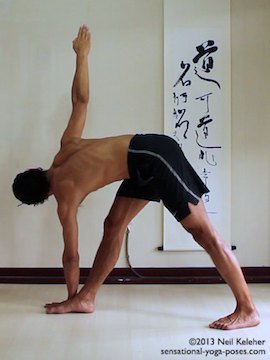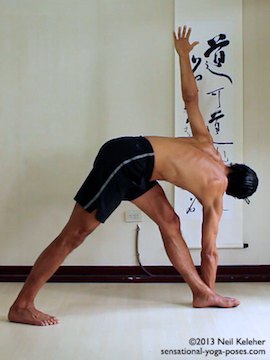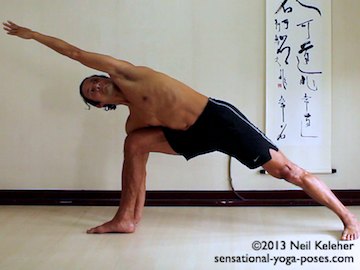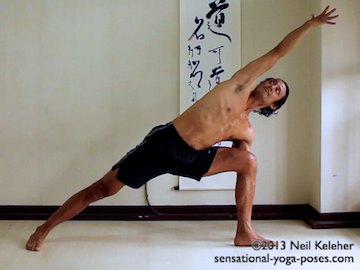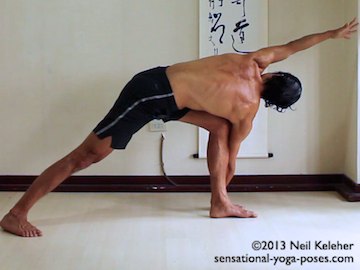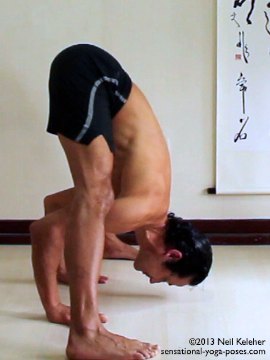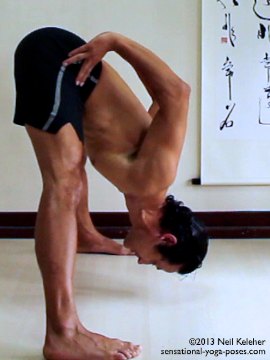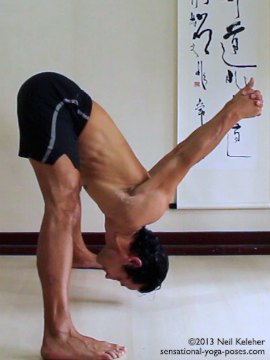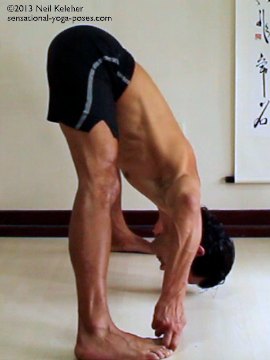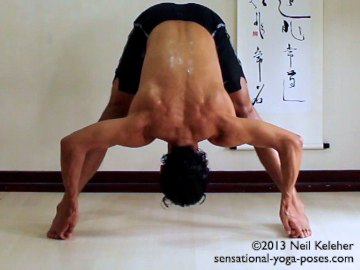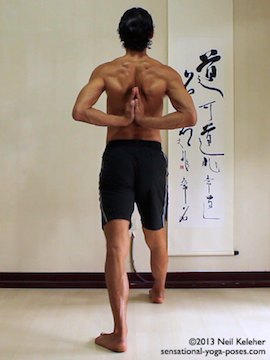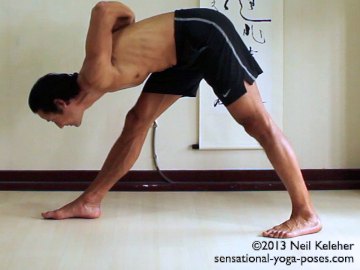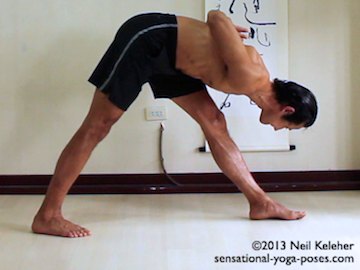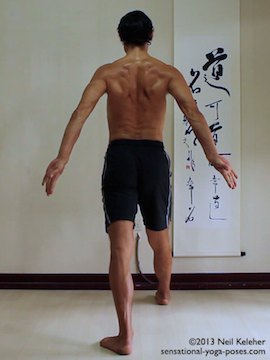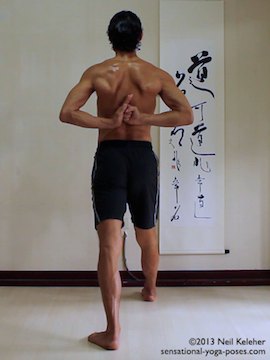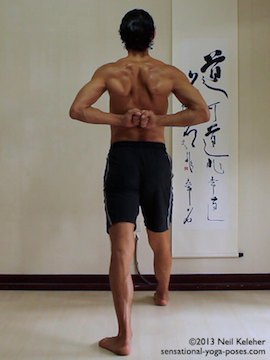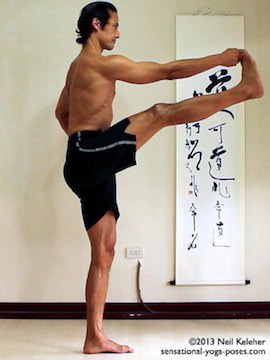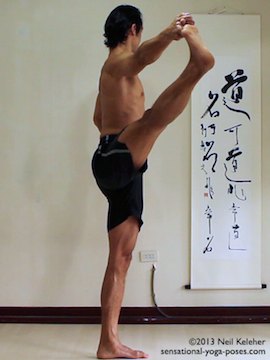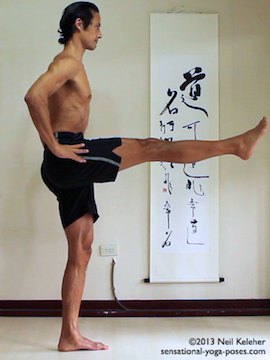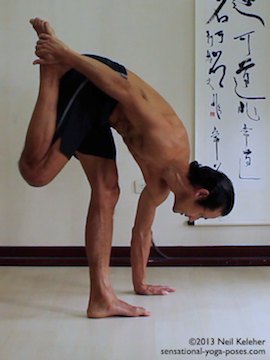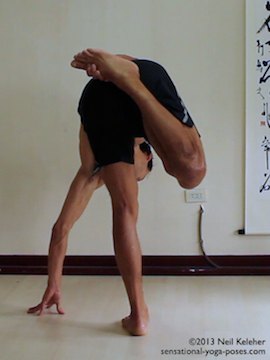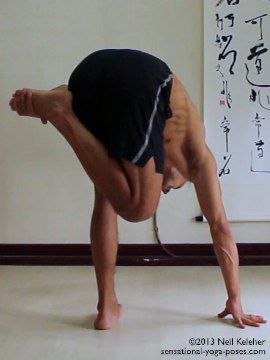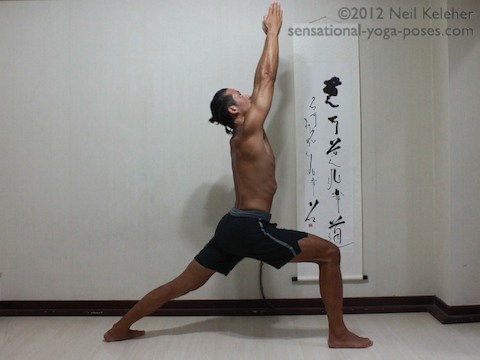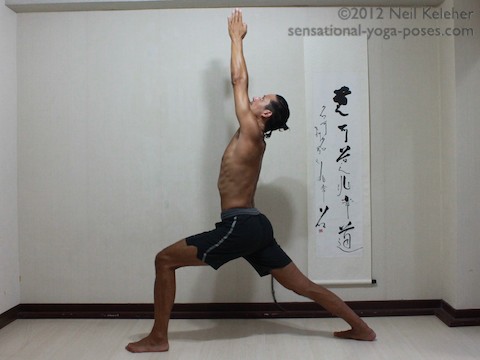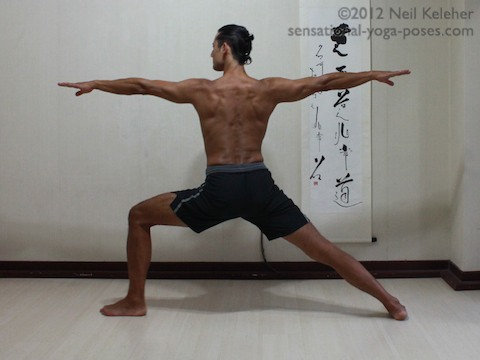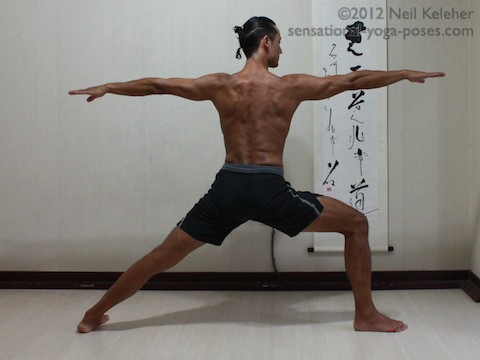Big Toe and Hands Under Feet Ashtanga Yoga Poses
After doing Sun Salutation a and Sun Salutation 3 to 5 times each, the first two ashtanga yoga poses are both forward bends.
Forward bends tend to be cooling, providing a good chance to rest and recover after sun salutations. They are also a chance to lengthen the hamstrings.
Big Toe Pose
In the first standing forward bend you grab on to your big toes with palms inwards (padangusthasana).
You could use your arms to pull your ribcage down, towards your feet. Another option is to pull your arms forwards, as if trying to pull your big toes out of your feet. Try looking back between your legs or look down, between your feet.
Hands Under the Feet Pose
In the second ashtanga yoga standing forward bend you slide your hands under your feet with palms upwards and fingers pointing towards your heels (padahastasana.)
Push your toes down into your wrists. Or lean forwards and press your toes into your wrists. Again you can use your arms to pull your ribcage down.
In both of these forward bends the feet are hip width apart. Make your legs feel long and your spine. You can lengthen each inhale and relax each exhale making both actions slow and smooth.
If you can't reach your toes, you can either bend your knees, or keep your knees straight and place your hands on your shins (or thighs.)
Feet Wider
In this next set of ashtanga yoga poses the feet are about a leg's length apart with both knees straight. (In the first two poses above the feet where about hip width apart.) These next two poses are triangle on both sides followed by twisting triangle
Trikonasana (Triangle)
Trikonasana is a forward facing side bend for the back hip and potentially a hamstring stretch for the front leg.
The front foot is turned out 90 degrees and the other foot is turned in slightly.
You can focus on relaxing the side of your body so that your ribcage sinks down. This may make it easier to reach for the toe with the bottom hand.
If you have grabbed the toe then you could focus on pulling your ribcage up, strengthening the side of the body.
Note the sideways tilt of my pelvis in the above two pictures. I like to drop the hip on the side I am leaning towards.
For variations of this pose read Triangle yoga pose.
Parivtta Trikonasana (Revolving Triangle)
In revolved (twisted) triangle the feet are still hip width apart and the knees are straight. In regular triangle pose your pelvis faces the long edge of your mat. In twisting triangle square your pelvis to the short edge of your mat. Your front foot faces forwards (relative to your pelvis) and your back foot is turned outwards slightly.
Usually I like to bend forwards with my hands either on my front shin or on the floor, and then after holding for a few breaths then I enter the twist. However, with practice you can twist as you bend forwards.
Ideally your back foot hand is on the floor but if you can't reach the floor then place your hand on your shin, or try to hold the pose with your hand lifted. In either case focus on making your spine feel long.
Keep your neck long and make your legs feel long also.
Feet Widest
For the next set of ashtanga yoga poses, the feet are even wider apart. In side angle pose one knee is bent. As with triangle you first do the non twisting side angle pose (uthitta parsvokonasana) on both sides first and then the twisting version (parivrtta parsvokonasana).
In the first two forward bends the feet were hip width. In the triangle set of ashtanga yoga poses the feet where a legs length apart. In this set of poses the feet are slightly wider apart. However one knee is bent while the other is straight.
Parsvokonasana (Side Angle Pose)
In side angle pose, I'd suggest that like in triangle pose, your first drop the hip of the turned out foot. Then bend the knee.
Try to position your feet so that your bent knee is just beyond the front of your ankle and the thigh is level.
Work at keeping the side tilt of the pelvis as you go deeper into the pose.
You can rest your bottom arm on your thigh, or touch fingers or palm to the floor.
Roll the top side of your pelvis and ribcage open. Roll the upper arm outwards so that elbow points forwards.
Pravirtta Parsvokonasana (Twisting Side Angle Pose)
In the twisting version of side angle pose (Pravrtta parsvokonasana) you can have your hands in prayer with one elbow resting on the thigh or you can try touching your bottom hand to the floor with your arm crossing the outside of the thigh.
Some teachers also suggest students placing their back knee on the floor for this ashtanga yoga pose.
Another option is to have the bottom hand to the inside of the front foot. You can then focus on stretching the front of the hip as well as twisting the ribcage and stretching the abdominal muscles.
You can also bind in this ashtanga yoga pose.
Four Wide Leg Forward Bends
The next set of ashtanga yoga postures is a series of four wide leg forward bends (prassaritta padottanasana).
These postures again stretch the hamstrings, but with the feet wider that in the first forward bends. These postures are all symmetrical.
In the fist and last posture of this set the hands are on the floor. In the second and third they are not.
Prasaritta Padotanasana A, B, C and D
- In the 1st pose the hands are shoulder width apart with the hands positioned on the floor so that the fingers point forwards.
The elbows are bent.
- In the 4th pose you grab your big toes and again and bend your elbows. (You can use your arms in these postures to help support your upper body weight.)
- In the 2nd ashtanga yoga pose of this set the hands are on the waist,
- while in the 3rd they are grabbing each other behind the back.
In Prasaritta Padotanasana A the hands are on the floor shoulder width apart with elbows bent. You can use your hands to help pull your chest between your legs. An option is to place your crown on the floor and lift up into tripod headstand.
In Prasaritta Padotanasana B the hands are on the waist. To help prepare for the next pose focus on drawing your shoulder blades towards each other.
In the C Position clasp hands behind back, make your arms long and then lift them. (This arm stretch is also called Dwikonasana)You could also open your palms and turn them outwards. Experiment with using your pectoralis minor muscles to pull the top of your shoulder blades forwards and down. Keep your neck long.
In the D Position grab your big toes. Bend your elbows. Make legs and spine feel long.
In order the hand positions are:
- hands on the floor shoulder width apart,
- hands on the waist
- hands grabbed behind the back
- grabbing the big toes
Parsvottansana: Praying Behind Your Back
The next Ashtanga Yoga Pose is prayer forward fold (Utthitta Parsvottanasan).
Your hands are in prayer behind the back with legs in the same position as in twisting triangle. You then bend forwards.
If you can't do prayer you can focus on rolling your arms inwards. (Hold or move to the next option.) From there try to bring hands together with one hand fisted and the other open or bring two fists together.
From the double fist option try to turn the backs of your hands uppermost and then open your hands and put the palms in prayer.
One possible aid for remembering how this pose follows the last four is that in the wide leg forward bends the legs are symmetrical and straight forming a pyramid shape. In this pose, the hands are together and form a pyramid shape.
Standing Balance Ashtanga Yoga Poses
After parsvottanasana (Prayer Behind the Back), the next two ashtanga yoga poses in the standing series are balance poses.
Utthitta Hasta Pagangusthasana (Hand to Big Toe Pose)
In hand to big toe pose (Utthitta Hasta Padangusthasana) you balance on one leg while holding on to the big toe of your lifted leg.
- In the first variation your lifted leg is to the front.
- In the next variation your move it to the side.
- Then finally you move it to the front and let go of your toe.
You could use a strap or belt to lasso your foot. Or you can bend the knee and grab it If you have trouble gripping you could also grab the side of the foot.
Ardha Baddha Padmasana (Half Bound Lotus Pose)
In Half Bound Lotus (Ardha Baddha Padmasana) you bend forwards while one leg is in lotus. Grab the lotus foot with the same side hand from behind the back.
The usual instruction is to bind while upright. However when you may find it easier to bind if you bend the standing leg knee and tip your upper body forwards about forty five degrees.
If you are uncomfortable in lotus you can grab your foot as if doing a standing quad stretch. You can then bend forwards and practice balancing even though you aren't in half lotus.
Initially grab with the same side hand. Then to work towards lotus externally rotate the lifted leg and grab the foot from behind the back. You can do this while bent forwards or try to bind while standing and then bend forwards.
Chair Pose and Two Warriors
The final three standing ashtanga yoga poses are Chair pose, Warrior 1 on both sides and then Warrior 2.
These three postures are possibly placed at the end of the standing sequence as a way of boosting heat prior to beginning the seated sequence of postures.
You could also think of them as a way to practice stabilizing the legs or strengthening them.
This sequence of yoga poses is a little bit like a modified sun salutation B.
Chair Pose
In utkatasana, you can bend your spine backwards or keep it straight. It can feel really nice if you tilt your pelvis backwards far emough to make your lower back feel full.
When you bend your knees sink your hips back. Lean your chest forwards for balance.
Neck long, reach your arms up.
Virabhadrasana (Warrior) 1
For warrior 1, the hips are square to the front. Bend your front knee so that the thigh is level. Make your spine feel long and reach your arms for the sky.
Vary your focus between sinking down low enough that your front thigh is horizontal, and keeping your pelvis square to the front.
Virabhadrasana (Warrior) 2
In warrior 2 the pelvis is turned to the side.
Use your lateral (side) thigh muscles to pull the bent knee outwards so that the knee is over the foot when viewed from the front.
Look at your front arm in this ashtanga yoga pose but stay aware of your back arm.
Vinyassas
Here are the vinyassa's for the standing poses.
Published: 2010 07 29
